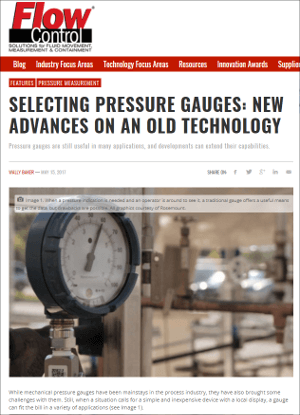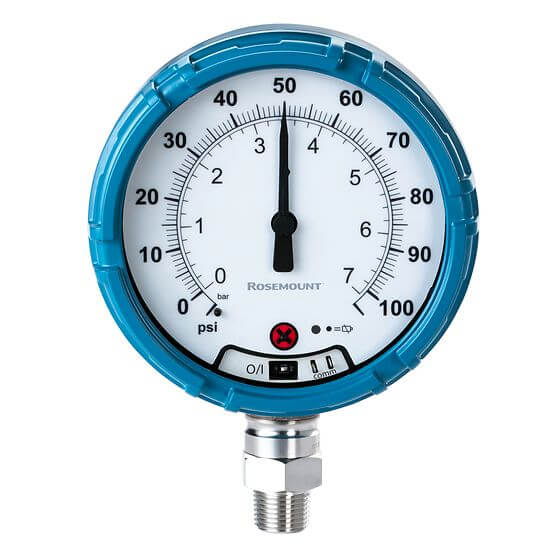Walk around most any industrial process manufacturing or production process and you’ll likely see pressure gauges providing feedback to operators who walk by. According to the Pressure Gauge entry in Encyclopedia.com, this technology:
While this approach has continued to be used, the advancement of digital technologies has created significant improvements in the design.…was invented by French industrialist Eugene Bourdon in 1849. It utilizes a curved tube design as the pressure sensing element. A less common pressure element design is the diaphragm or disk type, which is especially sensitive at lower pressures…
When the pressure medium (such as air, oil, or water) enters the tube through the socket, the pressure differential from the inside to the outside causes the tube to move.
 In a Flow Control article, Selecting Pressure Gauges: New Advances on an Old Technology, Emerson’s Wally Baker describes limitations with the historical approach and how digital communications make the information available more broadly than just locally at the gauge.
In a Flow Control article, Selecting Pressure Gauges: New Advances on an Old Technology, Emerson’s Wally Baker describes limitations with the historical approach and how digital communications make the information available more broadly than just locally at the gauge.
Wally highlights some of the shortcomings of the traditional design:
Gauges operate using delicate mechanisms with springs and gears, making them vulnerable to shock and damage… Most operators have seen typical failures with broken glass, bent indicator needles or needles pointing straight down from broken gearing. In many environments, they are considered essentially disposable because of their low cost and frequent failures.
He highlights some of the key selection considerations including ruggedness, material of construction, inlet configurations and overpressure & burst pressure limits. Accessories and special adaptions have been developed to contend with some of the limitations of traditional pressure gauges. These include snubbers, isolators or seals, siphons, fluid-filled casings, heat tracing, blowout cases and safety glass.
Digital gauges and electronic gauges have come along which provide some basic design improvements. Digital displays have replaced the mechanical needles in traditional gauges, and electronic gauges:
…use a strain-relief sensor rather than a Bourdon tube, processing the signal electronically rather than mechanically. The needle is driven by a tiny motor, so only one moving part is present, making the mechanism far more resistant to shocks and other extreme operating conditions.
 With Rosemount wireless pressure gauges, they are:
With Rosemount wireless pressure gauges, they are:
…able to monitor their own statuses. No way exists to verify a mechanical gauge is working properly short of removal from the process and testing, but a glance at an electronic gauge can show its operational status by a blinking LED. Even the battery life has been extended thanks to low-power electronics and highly efficient designs.
To move pressure readings beyond local display, a wireless pressure gauge adds:
…the capability to transmit its pressure reading via a WirelessHART mesh network. This additional communication capability adds “future-proofing” so it can be used in a sophisticated networking environment as the Industrial Internet of Things moves into more manufacturing applications.
Accessories required with traditional accessories are avoided.
Because this wireless pressure gauge is equipped with an advanced sensor design and additional isolator, it does not require a snubber. Its internal integral sensor isolator also keeps the process fluid from ever reaching the sensor, extending its working temperature range. Since it does not require a special configuration or other accessories, it is often a lower cost option than a traditional gauge in demanding applications.
Traditional pressure gauges still have their place. Read the article for suggestions where traditional mechanical gauges, electronic pressure transmitters and wireless pressure gauges make the best fit for the application.
You can also connect and interact with other pressure measurement experts in the Pressure group in the Emerson Exchange 365 community.





